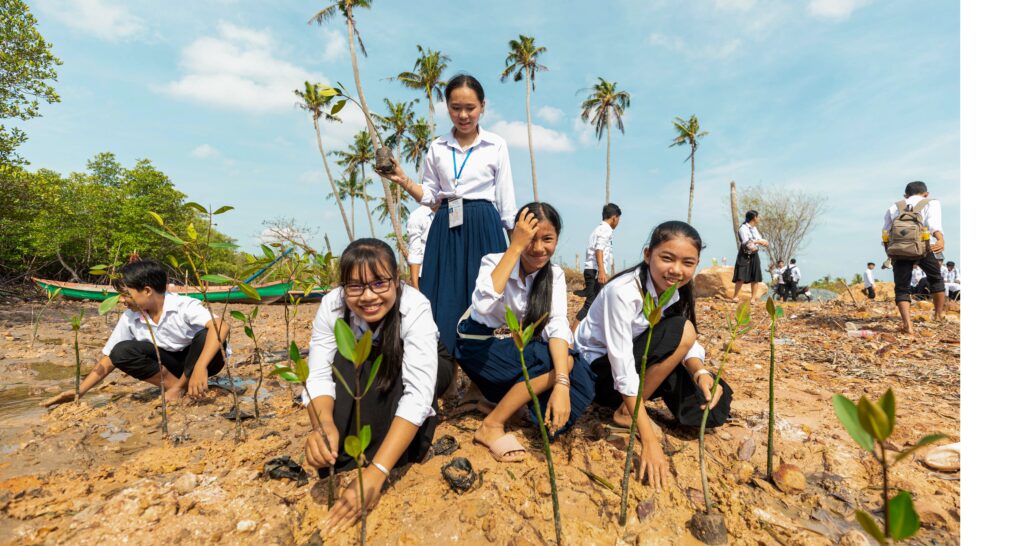Restoring land to combat climate change and degradation
We know how to restore land, and the benefits it brings to communities, climate, and biodiversity. Countries must act on land restoration now
Land use — Europe, Global

With accelerating climate change and biodiversity loss, the world is facing two complex and closely interrelated crises that require urgent action. The UN Framework Convention on Climate Change and the UN Convention on Biological Diversity provide established global frameworks and goals. But countries, businesses, and communities globally must now act to drive concrete action at the local level.
The restoration of degraded land is important for multiple environmental, social, and economic reasons. It needs to be scaled up and integrated with other efforts under a joint agenda for action on the Sustainable Development Goals (SDGs).
Tackling the ongoing degradation of land
Land degradation is one of the main drivers of both climate change and biodiversity loss. This occurs mainly through deforestation, wildfires, and soil degradation, which cause the release of greenhouse gases into the atmosphere. The conversion of primary forests to managed forests, illegal logging, and unsustainable forest management are also contributing to increasing emissions and biodiversity loss. In its Special Report on Climate Change and Land, the Intergovernmental Panel on Climate Change (IPCC) noted that over a quarter of the Earth’s ice-free land area is already degraded by human activity, undermining the well-being of 40% of the world population. This has led to an unprecedented level of biodiversity loss and over-exploitation of the world’s ecosystems (as noted by the Intergovernmental Science-Policy Platform on Biodiversity and Ecosystem Services (IPBES) in its Assessment Report on Land Degradation and Restoration).
Land degradation also deeply affects communities and their livelihoods. It reduces land productivity and increases extreme weather events such as wildfires and floods, and their associated economic costs. Land degradation and climate change together could reduce global crop yields by 10% by 2050, increasing to 50% in some regions, according to IPBES. Populations living in degraded areas are particularly vulnerable as they directly depend on natural resources for their subsistence, food security, and income. As the IPCC notes, this exacerbates existing inequalities and disproportionately affects women and youth. Land degradation and climate change are ‘threat multipliers’, leaving already precarious populations highly sensitive to extreme climatic events, with consequences such as poverty and food insecurity.
Countries must prioritize land restoration
The impacts of land degradation on biodiversity and climate have sparked ambitious objectives for land restoration at national, regional, and global levels. The benefits of land restoration for ecosystem resilience, local communities, nature, and biodiversity are broadly recognized. The International Union for Conservation of Nature (IUCN) estimate that land restoration could contribute to over a third of climate change mitigation required to meet global targets under the Paris Agreement.
A range of initiatives are already in place, from the ongoing UN Decade on Ecosystem Restoration to the New York Declaration on Forests, which seeks to restore 350 million hectares worldwide by 2030. Over 120 countries have engaged with the UN Convention to Combat Desertification on the 2018 to 2030 Strategic Framework to achieve land degradation neutrality and agreed to formulate voluntary targets.
These global efforts emphasize the long-term commitment needed to restore land and nature and must be complemented by targeted, nationally appropriate policies and measures in-country. Acting early can minimize risks, reduce losses, and generate immediate benefits to affected communities. However, only 1% of finances globally are directed toward restoration of the environment – even as it was found to be one of the most cost-effective approaches to absorb and store carbon dioxide (CO2) from the atmosphere. According to Strassburg et al. (2020), restoring 15% of converted lands in priority areas could sequester 299 billion tons of CO2, or 30% of the total atmospheric CO2 increase since the Industrial Revolution. This could serve as the foundation for ambitious 2050 global conservation and climate mitigation agendas.
Making land restoration a reality
Experts, UN agencies and practitioners are broadly in agreement on what is needed and known to make land restoration possible. Implementing known sustainable land management (SLM), restoration and rehabilitation practices should be a priority for countries. As the UN Convention to Combat Desertification explained in its 2017 report, SLM involves a range of technologies and practices and integrates local biophysical, socio-cultural and economic needs and values in decisions to holistically achieve long-term productive ecosystems.
Actions for land restoration are primarily focused on soil and water conservation, including the management of vegetation cover and soils, for example through tillage practices or nutrient supply to rebuild soil carbon, and agroforestry practices. Physical methods such as building terraces in hilly and mountainous terrain can reduce erosion and sediment transport but also result in durable changes to the landscape.
The costs and benefits of SLM and land restoration greatly depend on where and how it is done. As the IPCC explains, measures that support land restoration practices include tenure reform, tax incentives, payments for ecosystem services, participatory integrated land-use planning, farmer networks, and rural advisory services. While these measures are available, their adoption is generally limited to a minority of innovative land users and practitioners. Their implementation is restricted by economic, political, institutional, legal, and socio-cultural policy barriers. These barriers need to be addressed as a matter of urgency, including by:
- Tackling environmental constraints such as climate, topography, or soil quality.
- Providing appropriate technologies, practices or equipment.
- Researching and exploring the most suitable options to study unknown ecological implications at different scales.
- Addressing institutional and governance issues that aggravate or inhibit decision-making at different scales.
- Scaling up available finance and access to capital.
In developing integrated national climate and biodiversity strategies, countries should consider the tools and solutions most appropriate to their local context, and take the following into consideration:
Increase access to information, technologies and knowledge
Government plans should recognize and integrate local community needs, priorities, and expertise in the planning process, and integrate strong spatially explicit data on restoration potential. Stakeholder participation, which integrates indigenous and local knowledge and is gender-inclusive, should be included throughout the decision-making and implementation process.
Fill knowledge gaps
More research on co-benefits, trade-offs, barriers for implementation, and enabling conditions of different SLM technologies and practices in different contexts is needed. Decisions should consider species’ functional traits to maximize the effectiveness of the restoration potential: planting drought-adapted or fire-resilient species in landscapes forecasted to become arid increases the ecosystems resilience to hazards.
Develop resource-sharing practices and invest in capacity-building
Effective SLM practices in one area may not be the best option in another. Countries that share similar climatic challenges should prioritize knowledge-sharing to disseminate successful restoration strategies for climate change adaptation.
Develop effective, integrated services to support monitoring, evaluation and implementation
Moving away from sectoral policy design, implementing agricultural, land use, and water objectives coherently, and integrating them in climate and biodiversity strategies can support effective implementation. Policy coherence across scales is also critical.
Develop an appropriate policy-enabling environment
Appropriate incentives for landowners can enable and promote sustainable change.
Conclusion: integrated strategies and agendas
As Strassburg et al. (2020) point out, land preservation and restoration should be done with three criteria in mind:
- maximizing climate change mitigation
- biodiversity benefits
- the economic costs of inaction
This underscores the synergies that exist from linking the goals of the three UN Conventions (on climate change, combatting desertification, and biological diversity), as opposed to pursuing their targets in isolation.




